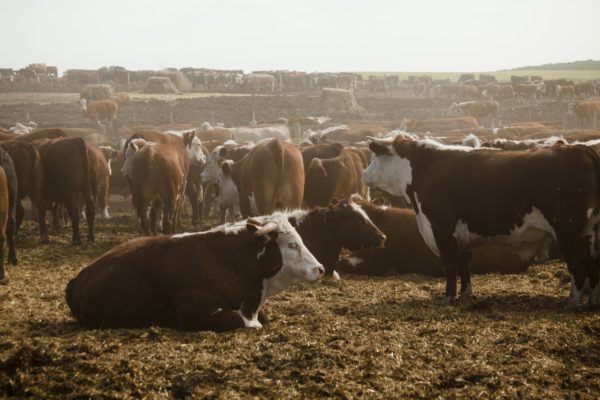

The COVID-19 pandemic has thrown all parts of the agriculture industry out of whack.
With consumers heading to the grocery store fewer times but buying in bulk, demand for certain basics has spiked. Eggs, for example, are selling like…well, like eggs during a crisis.
Another staple, at least in the United States, is beef, and beef sales are certainly up. But the price of live cattle has, astoundingly, gone down.
Given that only a few gigantic companies control the majority of the beef market in the US, some onlookers, including Senator Chuck Grassley (R-Iowa), smell something funny.
Grassley last week called for an investigation into “potential market and price manipulation, collusion, restrictions on competition and/or other unfair and deceptive practices,” as he wrote in a letter to the Attorney General and Secretary of Agriculture.
The past year has brought several accusations and lawsuits against the so-called big four companies that dominate the American meat industry.
Those four companies—JBS, Tyson, Smithfield, and Cargill—control more than 80 percent of the American beef industry, which gives a very small number of high-level players an uncomfortable amount of power.
Lawsuits within the past year have accused these companies of conspiring to keep cattle prices low and beef prices high, in part by closing functional processing plants in order to artificially reduce supply.
The price difference between the amount the big four pays for cattle and the amount they sell it for to consumers is sometimes referred to as “the spread.” The larger the spread, the bigger the profit—and those lawsuits allege illegal tactics to increase the size of that spread.
Now, with COVID-19 ravaging the country (and world, of course), that spread is getting larger. Beef sales have increased dramatically as consumers look to stock up on staples, especially those which freeze easily, like ground beef.
Sales have spiked, along with wholesale prices, as grocery stores sprint to restock their shelves. One study finds that meat sales in general are up about 91 percent compared with this same week last year; just for beef, that equals more than $180 million in increased sales.
And yet despite all of this, live cattle prices are down 16 percent since February 4th. That discrepancy—the big four getting rich while the ranchers actually lose money—has prompted a rare bipartisan show of anger, with both Democrats and Republicans noting their displeasure and suspicion of this state of affairs.
Secretary Perdue, to his credit, is aware of the problem, having at least tweeted about it:
.@USDA is actively monitoring all ag commodity markets & the flow of food from FARM TO FORK during the COVID 19 outbreak. We are paying special attention to the difference in prices from the farm gate to the grocery shelf.
— Sec. Sonny Perdue (@SecretarySonny) March 22, 2020
In the meantime, there’s actually a way to avoid the big four altogether. R-CALF, a nonprofit cooperative of smaller beef producers, launched a website to make it easier to find local beef. (R-CALF is one of the groups that sued for antitrust violations last year.)
Their site now provides a fairly extensive list of independent beef producers, along with phone numbers, websites, or other contact information. In short, it’s a Yellow Pages of non-big-four beef, a way to support producers outside that system.
That doesn’t, of course, help the ranchers who are stuck within the system, supplying those four companies. Systemic changes suggested by some Presidential candidates would address monopolies. In the meantime, hopefully the USDA has some bandwidth to see what’s going on here.
more recommended stories
 Fentanyl Seizures at Border Continue to Spike, Making San Diego a National Epicenter for Fentanyl Trafficking
Fentanyl Seizures at Border Continue to Spike, Making San Diego a National Epicenter for Fentanyl TraffickingFentanyl Seizures at Border Continue to.
 Utah Man Sentenced for Hate Crime Attack of Three Men
Utah Man Sentenced for Hate Crime Attack of Three MenTuesday, August 8, 2023 A.
 Green Energy Company Biden Hosted At White House Files For Bankruptcy
Green Energy Company Biden Hosted At White House Files For BankruptcyAug 7 (Reuters) – Electric-vehicle parts.
 Former ABC News Reporter Who “Debunked” Pizzagate Pleads Guilty of Possessing Child pδrn
Former ABC News Reporter Who “Debunked” Pizzagate Pleads Guilty of Possessing Child pδrnFriday, July 21, 2023 A former.
 Six Harvard Medical School and an Arkansas mortuary Charged With Trafficking In Stolen Human Remains
Six Harvard Medical School and an Arkansas mortuary Charged With Trafficking In Stolen Human RemainsSCRANTON – The United States.
 Over 300 People Facing Federal Charges For Crimes Committed During Nationwide Demonstrations
Over 300 People Facing Federal Charges For Crimes Committed During Nationwide DemonstrationsThe Department of Justice announced that.
